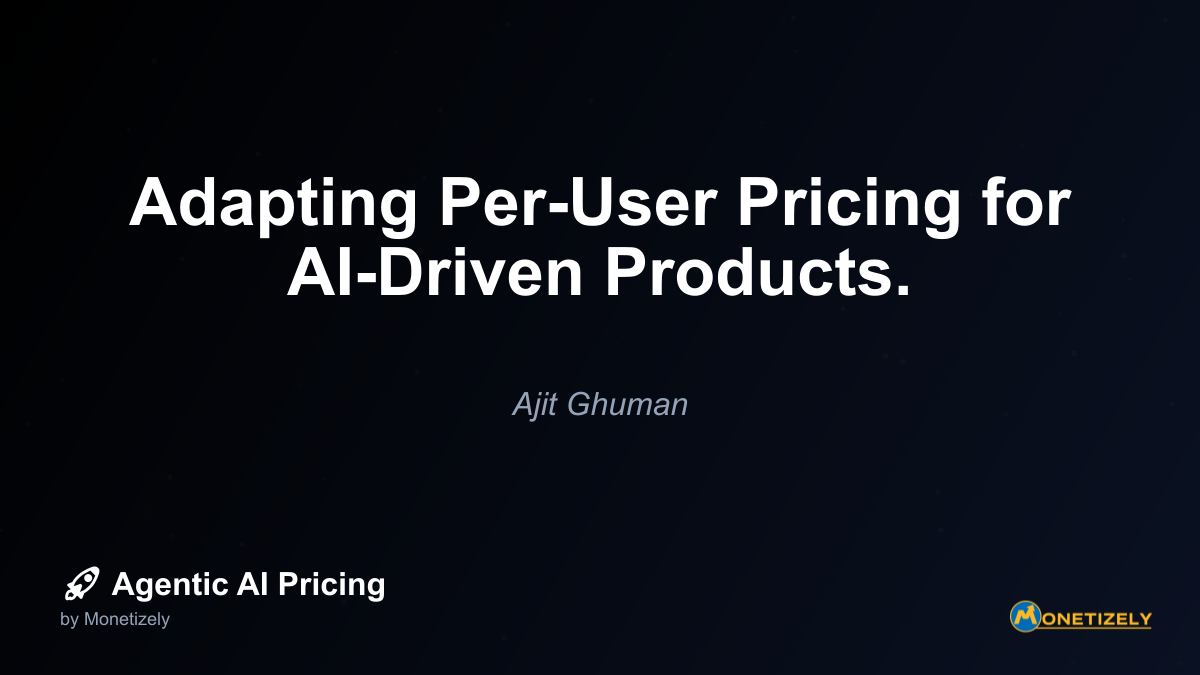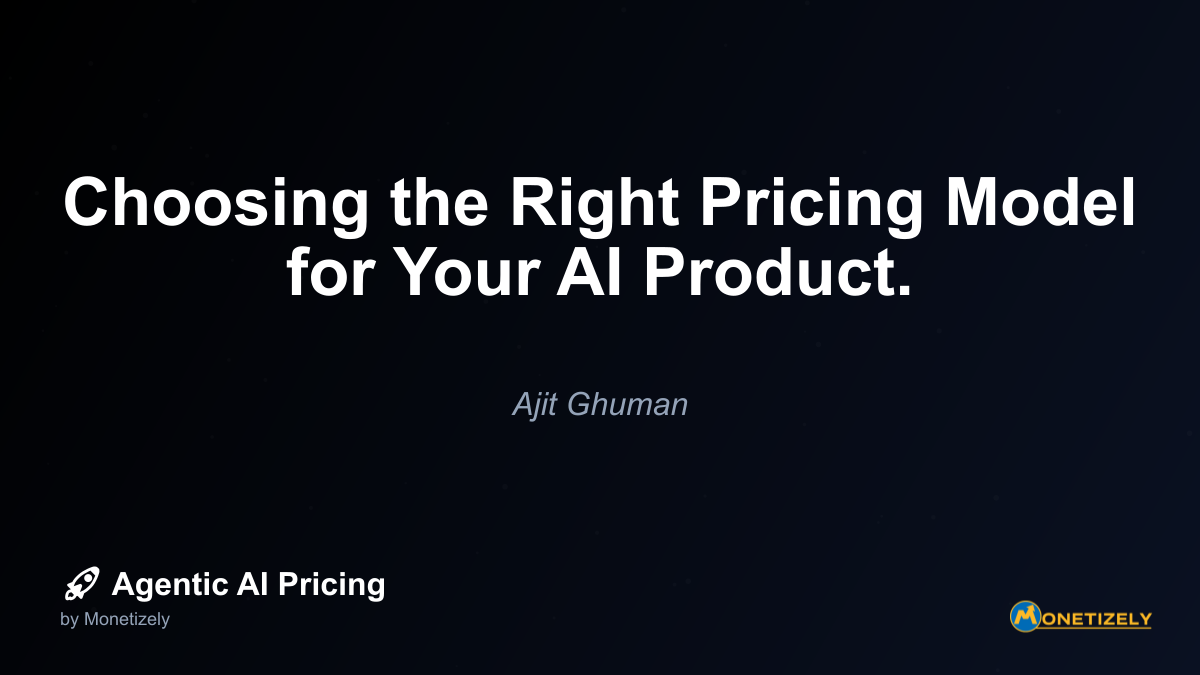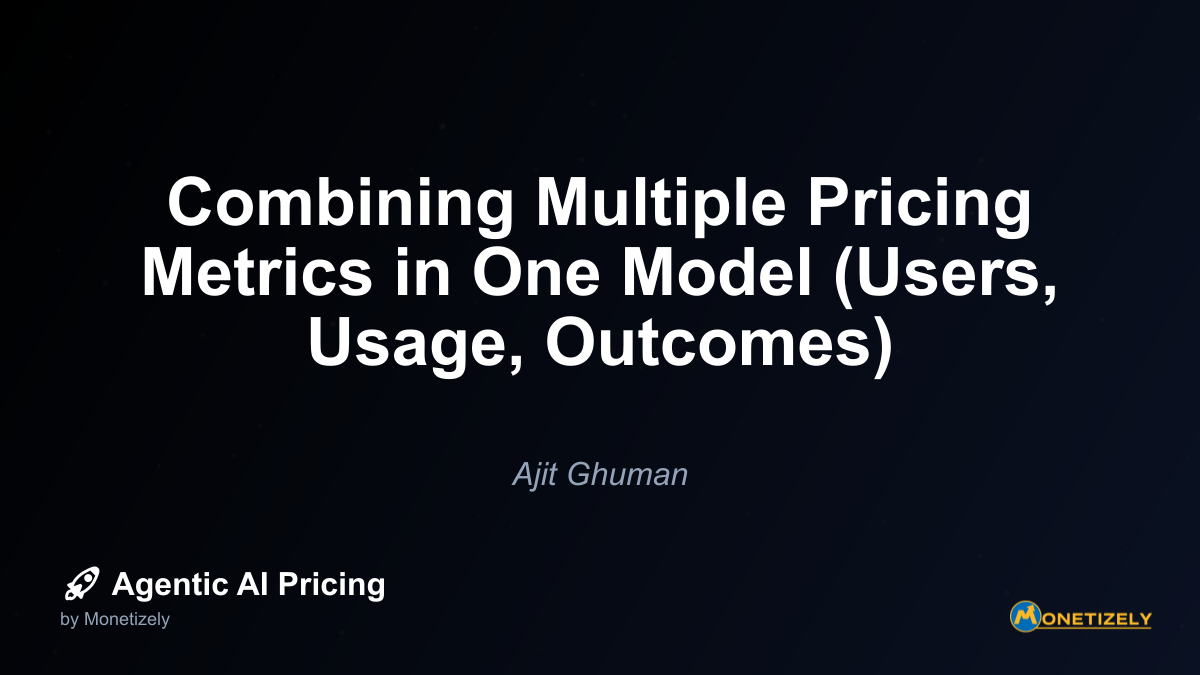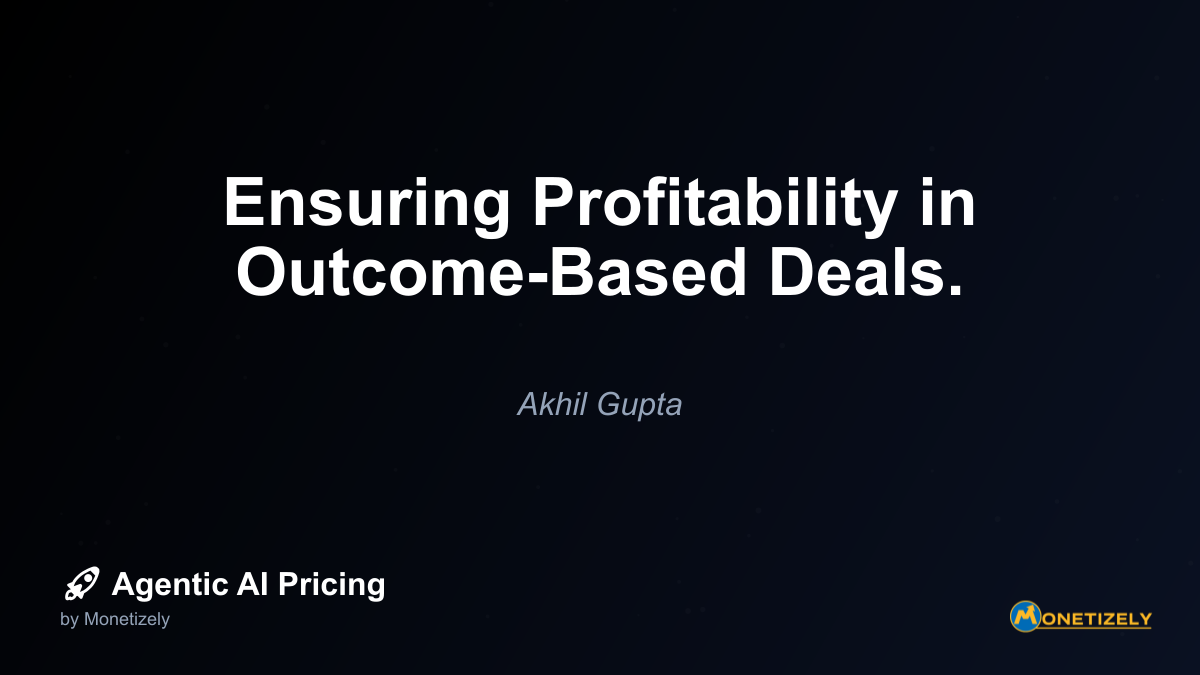· Akhil Gupta · Agentic AI Pricing Strategies · 12 min read
Transitioning from Per-Seat to Usage-Based Pricing.
AI and SaaS Pricing Masterclass
Learn the art of strategic pricing directly from industry experts. Our comprehensive course provides frameworks and methodologies for optimizing your pricing strategy in the evolving AI landscape. Earn a professional certification that can be imported directly to your LinkedIn profile.
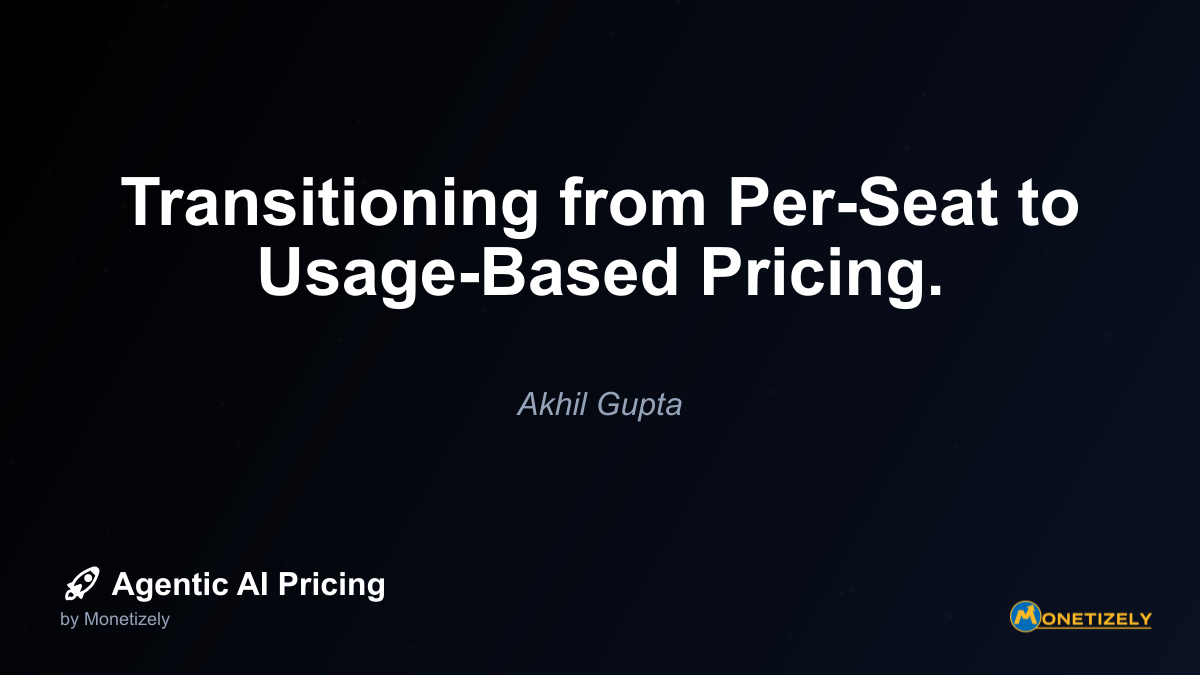
In today’s evolving AI landscape, businesses are increasingly recognizing the limitations of traditional per-seat pricing models. As AI technologies—particularly agentic AI—become more sophisticated and autonomous, the value they deliver transcends the number of human users accessing them. This fundamental shift is driving companies to reconsider their pricing strategies and embrace usage-based models that better align costs with the actual value delivered.
The Limitations of Per-Seat Pricing in an AI-Driven World
Per-seat pricing, once the gold standard for SaaS businesses, faces significant challenges in the age of AI. This model charges customers based on the number of individual users accessing the software, regardless of their actual usage patterns or the value they derive. While simple to understand and implement, it’s becoming increasingly misaligned with how AI solutions create and deliver value.
The fundamental problem is clear: as AI agents increasingly automate tasks previously performed by humans, the correlation between user seats and delivered value breaks down. An AI agent might replace the work of multiple human users while technically requiring only a single “seat.” This disconnect creates pricing inefficiencies where customers either:
- Pay for unused seats (overcharging)
- Receive disproportionate value from a small number of seats (undercharging)
- Find workarounds like sharing logins to avoid additional seat costs
These inefficiencies lead to suboptimal outcomes for both vendors and customers, creating friction in the sales process and potentially limiting adoption and expansion.
The Rise of Usage-Based Pricing in AI Applications
Usage-based pricing (UBP) has emerged as a compelling alternative, particularly for AI-powered solutions. This approach charges customers based on their actual consumption of specific resources or services, creating a direct link between price and value received.
According to recent research, there’s a marked shift away from traditional per-seat pricing, with AI companies increasingly adopting usage-based or outcome-based models. Companies sticking to per-seat pricing often experience lower gross margins and higher churn rates compared to those using usage or outcome-based models.
The trend is particularly pronounced in the AI sector, where:
- 73% of AI companies are still experimenting with pricing models, with an average of 3.2 different approaches tested in the first 18 months
- Hybrid pricing models, combining different pricing structures, have surged from 27% to 41% of companies
- AI companies average gross margins of 50-60%, compared to 80-90% for traditional SaaS
This shift is driven by several factors:
- Value Alignment: Usage-based pricing creates a stronger correlation between price and value delivered
- Scalability: Customers can start small and scale as their usage and value derived increases
- Flexibility: It accommodates diverse usage patterns across different customer segments
- Data-Driven Insights: Usage metrics provide valuable insights into customer behavior and product adoption
- Competitive Differentiation: It can be a competitive advantage in markets dominated by seat-based pricing
Strategic Framework for Transitioning to Usage-Based Pricing
Transitioning from per-seat to usage-based pricing requires a strategic, methodical approach. Here’s a comprehensive framework to guide this transition:
Phase 1: Strategic Planning and Alignment (Months 0-2)
Assemble a Cross-Functional Team
The first step is to form a dedicated team with representatives from:
- Finance
- Product
- Sales and Marketing
- Customer Success
- IT/Engineering
- Legal and Compliance
This team should be led by a designated “Chief Alignment Officer” responsible for orchestrating the transition and ensuring all departments work cohesively toward a common goal.
Define Your Value Metric
The cornerstone of effective usage-based pricing is selecting the right value metric—the unit of measurement that most closely aligns with the value customers derive from your product. For AI applications, common value metrics include:
- Compute resources used (API calls, processing time, inference requests)
- Data volume processed (GB, number of documents, images analyzed)
- Outcomes generated (reports created, decisions automated, predictions made)
- Value delivered (cost savings, revenue generated, time saved)
The ideal value metric should be:
- Easily understood by customers
- Directly correlated with customer value
- Measurable and trackable
- Scalable with customer growth
- Difficult to game or manipulate
Analyze Current Customer Usage Patterns
Before establishing pricing tiers, gather comprehensive data on how your customers currently use your product:
- Analyze usage patterns across different customer segments
- Identify high-value features and functionalities
- Understand usage variations by company size, industry, and use case
- Map current per-seat pricing to actual usage to identify misalignments
This data will inform your pricing structure and help predict how customers might respond to the transition.
Set Clear Objectives and Success Metrics
Define what success looks like for your pricing transition by establishing key performance indicators (KPIs) such as:
- Revenue growth and predictability
- Customer acquisition and retention rates
- Average revenue per user (ARPU)
- Customer lifetime value (LTV)
- Gross margin
- Net revenue retention (NRR)
- Customer satisfaction scores
These metrics will help you track the impact of the transition and make necessary adjustments.
Phase 2: Pricing Model Design and Testing (Months 2-4)
Develop Pricing Tiers and Structure
Based on your value metric and usage analysis, design a pricing structure that:
- Offers multiple tiers to accommodate different customer segments
- Includes appropriate volume discounts to incentivize increased usage
- Considers minimum commitments to ensure revenue predictability
- Potentially incorporates hybrid elements (base subscription + usage)
For example, a document processing AI might offer tiers based on the number of documents processed monthly:
- Starter: Up to 1,000 documents/month
- Professional: Up to 10,000 documents/month
- Enterprise: Custom volume with volume-based discounts
Create Financial Models and Forecasts
Develop comprehensive financial models to predict the impact of the transition:
- Project revenue under different adoption scenarios
- Model customer migration patterns from seats to usage
- Analyze potential cannibalization of existing revenue
- Forecast cash flow implications during the transition period
These models should account for:
- Different customer segments and their likely adoption rates
- Seasonal variations in usage
- Competitive responses
- Potential customer churn
Design and Implement Metering Infrastructure
Before launching usage-based pricing, ensure you have the technical infrastructure to accurately measure, track, and bill for usage:
- Implement robust usage tracking across all relevant metrics
- Develop real-time dashboards for internal monitoring
- Create customer-facing usage dashboards for transparency
- Test billing systems to ensure accuracy and reliability
- Set up alerts for unusual usage patterns or potential overages
Run Small-Scale Pilot Programs
Test your new pricing model with a limited subset of customers:
- Select “lighthouse” customers who are open to experimentation
- Include a mix of customer sizes and segments
- Offer incentives for early adoption
- Collect detailed feedback on the model and implementation
- Monitor usage patterns and financial impacts closely
Use the pilot to refine your pricing structure, communication strategy, and technical implementation before broader rollout.
Phase 3: Communication and Change Management (Months 4-6)
Develop a Comprehensive Communication Strategy
Effective communication is critical to a successful transition. Develop messaging that:
- Clearly articulates the rationale for the change
- Emphasizes the benefits to customers (flexibility, fairness, alignment with value)
- Addresses potential concerns proactively
- Provides tools and resources to help customers understand the impact
Tailor your messaging to different stakeholders:
- Existing customers
- Prospects in the sales pipeline
- Investors and shareholders
- Internal teams (especially sales and customer success)
Prepare Sales and Customer Success Teams
Your customer-facing teams will be on the front lines of this transition:
- Provide comprehensive training on the new pricing model
- Develop sales collateral and talking points
- Create tools to help estimate costs for prospects and customers
- Adjust compensation structures to incentivize the new model
- Role-play common customer objections and questions
Create Customer Education Resources
Help customers understand and adapt to the new pricing model:
- Develop detailed documentation and FAQs
- Create usage calculators and estimators
- Offer webinars and training sessions
- Provide case studies showing the benefits of usage-based pricing
- Establish clear channels for questions and support
Phase 4: Phased Implementation (Months 6-18)
Implement for New Customers
Begin by implementing the new pricing model for new customers while maintaining existing agreements for current customers:
- Update your pricing page and sales materials
- Train the sales team on positioning the new model
- Monitor conversion rates and deal sizes carefully
- Gather feedback from prospects and new customers
- Make adjustments as needed based on market response
Gradual Migration of Existing Customers
Develop a strategy for migrating existing customers to the new model:
- Time transitions with contract renewals when possible
- Offer incentives for early adoption
- Provide grandfathering options or extended transitions for strategic accounts
- Create migration paths that minimize disruption and risk
- Consider hybrid approaches during transition periods
Monitor and Optimize
Continuously track performance against your success metrics:
- Analyze usage patterns and customer behavior
- Monitor revenue impact and predictability
- Track customer satisfaction and feedback
- Identify and address any issues or concerns quickly
- Make iterative improvements to the model based on data
Case Studies: Successful Transitions to Usage-Based Pricing
Algolia (Search-as-a-Service)
Original Model: Per-seat licensing with tiered plans New Model: Pay-as-you-go based on search requests and indexing volume Transition Approach: Algolia implemented a gradual transition, starting with a hybrid model that included minimum commitments plus usage-based charges. They marketed the low-barrier entry, encouraging developers to start small and scale seamlessly. Communication Strategy: Emphasized the fairness of paying only for what you use, with transparent pricing documentation and usage calculators. Results: Expanded total addressable market by attracting smaller teams and startups unable to commit upfront to seats. Enabled natural expansion as usage increased. Key Learning: The right usage metric (search operations) directly correlated with the value customers received, making the transition intuitive and fair.
ChatGPT by OpenAI
Original Model: Free tier with paid subscriptions New Model: Hybrid—subscription access + pay-for-usage overage charges, especially for API calls Transition Approach: OpenAI introduced a tiered model with basic subscription access and additional charges for advanced API usage based on tokens processed. Communication Strategy: Transparency in pricing documentation, with clear quotas and overage fees. Provided detailed explanations of how token usage works. Results: Massive user growth with monetization aligning to compute resource consumption rather than user seats. Key Learning: Hybrid approaches can ease the transition while creating alignment between costs and value.
Salesforce
Original Model: Per-seat subscriptions New Model: Bundled AI/automation features within seat licenses with additional usage charges for premium API calls or AI insights Transition Approach: Salesforce gradually introduced usage-based elements for specific features and services while maintaining its core seat-based model for user access. Communication Strategy: Offering tiered plans with usage credits, discounts for larger seat commitments, and gradual rollout of usage charges. Results: Increased average revenue per user (ARPU) by monetizing value-driving automation and AI features beyond users. Key Learning: Even traditional SaaS companies can successfully incorporate usage elements for AI features where the value isn’t tied to user counts.
Common Challenges and How to Address Them
Challenge 1: Revenue Predictability
Issue: Usage-based pricing can introduce revenue variability and make forecasting more difficult.
Solutions:
- Implement minimum commitments or base subscriptions to provide a revenue floor
- Use historical usage data to improve forecasting accuracy
- Develop sophisticated forecasting models that account for usage patterns
- Consider offering discounts for upfront commitments to usage levels
Challenge 2: Customer Resistance
Issue: Customers accustomed to predictable, seat-based pricing may resist the change due to budget uncertainty.
Solutions:
- Provide transparent usage dashboards and spending controls
- Offer usage caps or alerts to prevent unexpected charges
- Create cost calculators and estimators for budgeting
- Consider gradual transitions with hybrid models
- Demonstrate the ROI and value alignment of the new model
Challenge 3: Sales Team Alignment
Issue: Sales teams optimized for seat-based selling may struggle with the transition.
Solutions:
- Adjust compensation plans to incentivize usage-based deals
- Provide comprehensive training on value selling
- Develop clear playbooks and talk tracks
- Create case studies and references showcasing successful customers
- Consider specialized sales roles focused on usage expansion
Challenge 4: Technical Implementation
Issue: Accurately tracking, measuring, and billing for usage requires robust technical infrastructure.
Solutions:
- Invest in reliable metering and billing systems
- Implement thorough testing and validation processes
- Ensure data accuracy and auditability
- Build customer-facing dashboards for transparency
- Consider third-party solutions specialized in usage-based billing
Challenge 5: Internal Alignment
Issue: Different departments may have conflicting priorities and concerns about the transition.
Solutions:
- Establish clear executive sponsorship and leadership
- Create a cross-functional transition team
- Develop shared success metrics and incentives
- Communicate regularly about progress and challenges
- Address concerns proactively and transparently
Determining the Right Usage Metrics for AI Applications
Selecting appropriate usage metrics is perhaps the most critical decision in transitioning to usage-based pricing. For AI applications, especially agentic AI, consider these approaches:
Input-Based Metrics
These metrics focus on the resources consumed by the AI:
- API calls or requests
- Compute time or resources used
- Data volume processed
- Number of model parameters or complexity
Best for: Applications where resource consumption correlates well with customer value and when costs scale linearly with usage.
Output-Based Metrics
These metrics focus on what the AI produces:
- Documents generated
- Images created
- Reports compiled
- Decisions automated
- Predictions made
Best for: Applications where the output directly represents the value delivered to customers.
Outcome-Based Metrics
These metrics focus on the business impact of the AI:
- Cost savings achieved
- Revenue generated
- Time saved
- Efficiency gained
- Error reduction
Best for: High-value applications where the AI directly impacts business outcomes and the impact can be reliably measured.
Hybrid Metrics
Many successful AI pricing models combine multiple metric types:
- Base subscription + usage overage
- Tiered usage with different rates
- Different metrics for different features or modules
Best for: Complex applications with multiple value dimensions or when transitioning from traditional models.
Financial Modeling During the Transition
Transitioning to usage-based pricing requires careful financial planning and modeling to ensure stability during the change.
Revenue Forecasting Approaches
Historical Usage Analysis: Analyze existing customer usage patterns to project future consumption and revenue.
Cohort-Based Modeling: Model different customer segments separately based on their unique usage characteristics.
Monte Carlo Simulations: Use probabilistic models to account for usage variability and uncertainty.
Scenario Planning: Develop multiple scenarios (conservative, moderate, aggressive) to understand the range of possible outcomes.
Key Financial Metrics to Track
During the transition, closely monitor these financial indicators:
Revenue Mix: Percentage of revenue from per-seat vs. usage-based charges
Average Revenue Per User (ARPU): Trending usage-based ARPU vs. legacy ARPU
Usage Growth: Volume of consumption metrics over time per customer cohort
Customer Lifetime Value (LTV): Especially changes post-transition due to pay-for-value alignment
Churn and Retention Rates: To monitor the impact of pricing changes on customer loyalty
Gross Margin on Usage Revenue: To ensure new pricing supports operational costs
Revenue Predictability: Variance in monthly recurring revenue (MRR) and usage variability
Customer Adoption Rate: Percent of customers moved to new pricing model or hybrid plans
Managing Investor Expectations
For public companies or those with external investors, managing expectations during the transition is crucial:
Transparent Communication: Clearly explain the strategic rationale and expected financial impact.
Revised Metrics: Introduce new KPIs that better reflect the usage-based business model.
Transition Timeline: Provide a clear timeline for the transition and key milestones.
Benchmark Comparisons: Share relevant benchmarks from other companies that have successfully made similar transitions.
Effective Customer Communication Strategies
How you communicate the pricing change to customers can significantly impact its success. Here are strategies for effective communication:
Emphasize Value Alignment
Frame the change as an opportunity for customers to pay for the actual value they receive:
- “Pay only for what you use”
- “Scale costs with your success”
- “Align spending with value received”
Provide Transparency and Control
Give customers the tools to understand and manage their usage:
- Real-time usage dashboards
- Spending caps and alerts
- Usage forecasting tools
- Clear documentation on how usage is measured
Offer Transition Support
Make the change as smooth as possible:
- Dedicated customer success managers
- Training sessions and resources
- Gradual migration options
- Grandfathering for certain customers
- Trial periods with the new model
Address Common Objections
Prepare for and proactively address typical customer concerns:
Objection: “We need budget predictability.” Response: ”
Co-Founder & COO
Akhil is an Engineering leader with over 16+ years of experience in building, managing and scaling web-scale, high throughput enterprise applications and teams. He has worked with and led technology teams at FabAlley, BuildSupply and Healthians. He is a graduate from Delhi College of Engineering and UC Berkeley certified CTO.
Pricing Strategy Audit
Let our experts analyze your current pricing strategy and identify opportunities for improvement. Our data-driven assessment will help you unlock untapped revenue potential and optimize your AI pricing approach.

